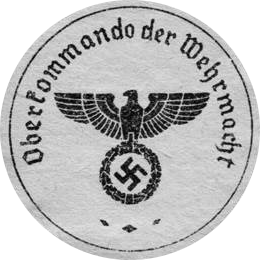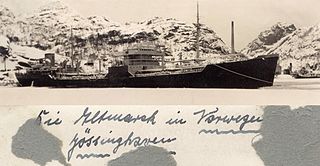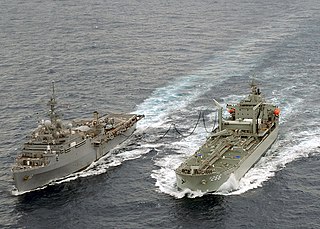Background
The German supply system intended to serve the navy overseas, named Etappendienst, was set up in 1911. Its key section, designed to supply warships active in the Atlantic, was based in Spain, and operated especially in 1914–1915. [1] Dissolved after the First World War, Etappendienst was re-established in the mid-1930s; initially part of the Abwehr, in mid-1938 it was moved to the Foreign Section of OKW. [2] Though technically one of 4 global Etappendienst centres, Spain became the focus of the plan; in 1934-1935 by means of various front companies the Germans constructed a network supposed to ensure supplies of fuel, sourced mostly in Latin American countries. [3] Following disruption caused by the Spanish Civil War, the works were resumed in 1938. They were paired with official diplomatic efforts directed at the Franco government, and included plans of German investment and co-ownership of the CEPSA refinery in the Canary Islands. [4] The Spanish Nationalist government remained cautious and in early 1939 OKW issued a directive which envisioned nothing more than “benevolent neutrality” of Spain should a major European conflict begin. [5] This marked German reversal to the concept of supplies through cover organizations, though operated with consent of the Spanish administration. [6]
Negotiations
In 1939 the Berlin and the Madrid governments discussed various options of implementing the scheme; plans varied between using Spanish or German merchant ships, servicing only submarines or also surface vessels including cruisers, replenishment taking place in ports or in some isolated bays, purchases of fuel/supplies being made in Spain or abroad. At one point, discouraged by Spanish reluctance, delays and ambiguity, the Germans considered reverting to entirely clandestine operations, but given tightly controlled market and heavy policing in post-war Spain, the option was abandoned as entirely unfeasible. [7] Given domination of the Royal Navy, the Spaniards were principally concerned with a would-be British counter-action; on the other hand, also the Germans worked under instructions not to compromise Spanish neutrality. The final agreement was reached by Beigbeder and Stohrer in November 1939. It covered submarines only; they were to draw at night alongside a German tanker anchored in the port, take on supplies and sail off before dawn. Spanish authorities were supposed to close their eyes and enable provisions from land depots. [8]
Replenishment operations
Sources differ and list 25-26 cases of German submarines serviced in Spanish ports documented, [9] taking place between January 1940 and February 1944: 5 in 1940, 16 in 1941, 3 (2) in 1942, none in 1943 and 1 (0) in 1944. [10] Most were scheduled operations and 3 were emergency cases. The ports used were Vigo (7-8), Las Palmas (6), Cádiz (6) and El Ferrol (5). Overall, there were 1,508 tons of gasoil and 37 tons of heavy oil pumped; in most cases there was also lubricants, water and foodstuffs delivered, in some cases navigation charts and first-aid kits, and in 3 cases there were torpedoes loaded. [11] In few cases injured or sick German sailors were taken off the ship. Almost all cases were overnight operations, though two emergency repairs took a few days. There were 4 German supply ships ("Thalia", "Bessel", "Max Albrecht" and "Corrientes") involved. In one case the replenishment operation was abandoned, as it turned out that the submarine in question was damaged and unfit for the process. [12] On the navy side the operations were co-ordiated by Oberkommando der Marine, in Spain the process was managed by the German navy attaché in Madrid, Kurt Meyer-Döhner.
Phasing out
Though usually performed in total secrecy, in few cases replenishment operations lasted until daylight and even attracted some crowds watching from the shores. The British gained indication of provisioning, but lacked evidence, especially that since July 1940 Franco, disappointed with Hitler's refusal to discuss Spanish territorial claims in Africa, suspended supply operations; [13] they were resumed in March 1941. In July 1941 the British embassy in Madrid lodged a formal protest, pointing to breach of Spanish neutrality obligations. [14] Since mid-1941 the British intelligence had already irrefutable proof, and in late 1941 they captured sailors from U-434, shortly after she had re-fuelled at Vigo. [15] Following a series of British protests, in late 1941 the Spanish terminated their operations in the Canary Islands [16] and scaled down the process altogether, in principle reduced to emergency operations. [17] In May 1942 the Spanish for the first time interned a German submarine which sought refuge following combat damages, the submarine was eventually sold to the Spanish Navy; 1 other case is known for 1943. Usually the German crew were initially interned, but under various circumstances they made it back to Germany. [18]

The Kriegsmarine was the navy of Nazi Germany from 1935 to 1945. It superseded the Imperial German Navy of the German Empire (1871–1918) and the inter-war Reichsmarine (1919–1935) of the Weimar Republic. The Kriegsmarine was one of three official branches, along with the Heer and the Luftwaffe, of the Wehrmacht, the German armed forces from 1935 to 1945.

The Oberkommando der Wehrmacht was the supreme military command and control office of Nazi Germany during World War II. Created in 1938, the OKW replaced the Reich Ministry of War and had oversight over the individual high commands of the country's armed forces: the army, navy, and air force.

A blockade runner is a merchant vessel used for evading a naval blockade of a port or strait. It is usually light and fast, using stealth and speed rather than confronting the blockaders in order to break the blockade. Blockade runners usually transport cargo, for example bringing food or arms to a blockaded city. They have also carried mail in an attempt to communicate with the outside world.

The siege of Malta in World War II was a military campaign in the Mediterranean theatre. From June 1940 to November 1942, the fight for the control of the strategically important island of the British Crown Colony of Malta pitted the air and naval forces of Fascist Italy and Nazi Germany against the Royal Air Force (RAF) and the Royal Navy.

USS Patoka (AO–9/AV–6/AG–125) was a replenishment oiler made famous as a tender for the airships Shenandoah (ZR-1), Los Angeles (ZR-3) and Akron (ZRS-4). It was also notable in that its height figured prominently in the design of the Rainbow Bridge in Texas.

USS Betelgeuse (AK-260) was the last of the cargo ships in service in the United States Navy. On 10 April 1944, it was renamed the SS Colombia Victory after being launched as a Victory ship to carry cargo during World War II. She was transferred to the US Navy in 1951.

Altmark was a German oil tanker and supply vessel, one of five of a class built between 1937 and 1939. She is best known for her support of the German commerce raider, the "pocket battleship" Admiral Graf Spee and her subsequent involvement in the "Altmark Incident". In 1940 she was renamed Uckermark and used as supply tanker for the battleships Scharnhorst and Gneisenau during Operation Berlin before sailing to Japan on September 1942 as a blockade breaker.

A replenishment oiler or replenishment tanker is a naval auxiliary ship with fuel tanks and dry cargo holds which can supply both fuel and dry stores during underway replenishment (UNREP) at sea. Many countries have used replenishment oilers.

The Battle of the Mediterranean was the name given to the naval campaign fought in the Mediterranean Sea during World War II, from 10 June 1940 to 2 May 1945.

USS Bulmer (DD-222/AG-86) was a Clemson-class destroyer in the United States Navy during World War II. It was the last warship of the Asiatic Fleet in USN commission.

Underway replenishment (UNREP) or replenishment at sea (RAS) is a method of transferring fuel, munitions, and stores from one ship to another while under way. First developed in the early 20th century, it was used extensively by the United States Navy as a logistics support technique in the Pacific theatre of World War II, permitting U.S. carrier task forces to remain at sea indefinitely.

During World War II, the Spanish State under Francisco Franco espoused neutrality as its official wartime policy. This neutrality wavered at times, and "strict neutrality" gave way to "non-belligerence" after the Fall of France in June 1940. Franco wrote to Adolf Hitler offering to join the war on 19 June 1940 in exchange for help building Spain's colonial empire. Later in the same year Franco met with Hitler in Hendaye to discuss Spain's possible accession to the Axis Powers. The meeting went nowhere, but Franco did help the Axis—whose members Italy and Germany had supported him during the Spanish Civil War (1936–1939)—in various ways.

Vesihiisi was a Finnish 500-tonne Vetehinen-class submarine that was constructed in the early 1930s. The vessel served in the Finnish Navy during the second World War.

At the start of World War II in 1939, the Portuguese Government announced on 1 September that the 550-year-old Anglo-Portuguese Alliance remained intact, but since the British did not seek Portuguese assistance, Portugal was free to remain neutral in the war and would do so. In an aide-mémoire of 5 September 1939, the British government confirmed the understanding. As Adolf Hitler's occupation swept across Europe, neutral Portugal became one of Europe's last escape routes. Portugal was able to maintain its neutrality until 1944, when a military agreement was signed to give the United States permission to establish a military base in Terceira Island in the Azores and thus its status changed to non-belligerent in favour of the Allies.

USS Alcor, AK-259, was a Greenville Victory-class cargo ship in service with the United States Navy from 1952 to 1968. She was originally built in 1944 as SS Rockland Victory, a World War II era Victory ship. She was sold for scrap in 1970.
At the beginning of World War II, the Royal Navy was the strongest navy in the world, with the largest number of warships built and with naval bases across the globe. It had over 15 battleships and battlecruisers, 7 aircraft carriers, 66 cruisers, 164 destroyers and 66 submarines. With a massive merchant navy, about a third of the world total, it also dominated shipping. The Royal Navy fought in every theatre from the Atlantic, Mediterranean, freezing Northern routes to Russia and the Pacific ocean.
World War II was the first war where naval aviation took a major part in the hostilities. Aircraft carriers were used from the start of the war in Europe looking for German merchant raiders and escorting convoys. Offensive operations began with the Norwegian campaign where British carriers supported the fighting on land.

Operation Pilgrim was a planned British operation to invade and occupy the Canary Islands during World War II. The invasion was a contingency plan to be executed in the event of a known plan whereby Germany would support Spain in occupying Gibraltar, the Azores, the Canary Islands as well as the Cape Verde Islands. The British feared that such occupation would materially affect Allied access to the Mediterranean and endanger Britain’s shipping-lanes to its Dominions. Operation Pilgrim was a preemptive invasion and occupation to prevent German control of the islands. The German invasion never materialised and consequently, Operation Pilgrim was never put into action.

Sidi Ferruch was a French Navy Redoutable-class submarine of the M6 series commissioned in 1939. She participated in World War II, first on the side of the Allies from 1939 to June 1940, then in the navy of Vichy France. She was sunk in November 1942.

















